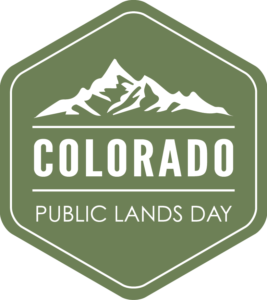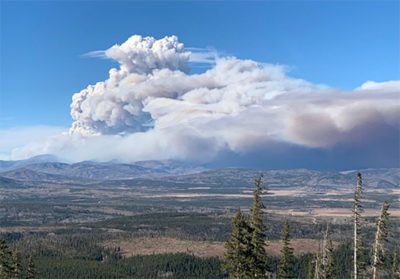
The Arkansas Hills to the east of Salida and Tenderfoot Mountain were a potential target of development if the BLM “preferred” plan D (allowing mining development) had been selected during the Trump years. Now the new Public Lands Rule will place equal weight on protecting the land’s health and recreation uses, not just extractive mining. Photo EcoFlight.
Biden Administration Finalizes Strategy to Guide Balanced Management, Putting the Conservation of Public Lands and Recreation on an Equal Footing with Extractive Industries
As big deals go — the Public Lands Rule (PLR) is a very big deal, especially for Western states, and in mountain counties, where much of the public land exists.
After not just months, but a full year’s work, the just-published PLR will help conserve wildlife habitat, restore places impacted by wildfire and drought, expand outdoor recreation, and guide thoughtful development in a way that makes protection of these wild places at least an equal footing with those who would extract minerals and other resources.
On April 18, the Department of the Interior announced a final rule (the federal guidelines publish on April 24) to help guide the balanced management of America’s public lands. The final Public Lands Rule provides tools for the Bureau of Land Management (BLM) to help improve the health and resilience of public lands in the face of a changing climate; conserve important wildlife habitat and intact landscapes; facilitate responsible development; and better recognize unique cultural and natural resources on public lands.
“As stewards of America’s public lands, the Interior Department takes seriously our role in helping bolster landscape resilience in the face of worsening climate impacts,” said Secretary Deb Haaland on the day of the announcement. “Today’s final rule helps restore balance to our public lands as we continue using the best-available science to restore habitats, guide strategic and responsible development, and sustain our public lands for generations to come. Complemented with historic investments from President Biden’s Investing in America agenda, we are implementing enduring changes that will benefit wildlife, communities, and habitats.”
The Public Lands Rule builds on historic investments in public lands, waters, and clean energy deployment provided by President Biden’s Investing in America agenda. It sets forth this right: it recognizes the critical value of our public lands, not just for some, but for all Americans.
This PLR is also intended to complement the “America the Beautiful initiative”, a 10-year, locally led and nationally scaled effort to protect, conserve, connect, and restore the lands, waters, and wildlife upon which we all depend.
The new rule builds on decades of land management experience and emphasizes the use of science and data, including Indigenous Knowledge, to guide balanced decision-making. The rule applies the existing fundamentals of land health across BLM programs, establishes restoration and mitigation leases, and clarifies practices to designate and protect Areas of Critical Environmental Concern (ACECs). The rule will help to ensure the BLM continues to protect land health while managing other uses of the public lands, such as clean energy development and outdoor recreation.

Colorado Public Lands Day is coming up in May. Logo courtesy of Colorado Public Lands website
“America’s public lands are our national treasures and need to be managed and made resilient for future generations of Americans,” said Senior Advisor to the President for International Climate Policy John Podesta. “Today’s final rule from the Department of the Interior is a huge win for ensuring balance on our public lands, helping them withstand the challenges of climate change and environmental threats like invasive species, and making sure they continue to provide services to the American people for decades to come.”
It could be said that the Public Land Rule, which will help the BLM navigate changing conditions on the ground, while helping public lands continue to serve as economic drivers across the West, is long overdue.
It comes amid growing pressures and historic challenges facing land managers. They include: the impacts of climate change—including prolonged drought, increasing wildfires, and an influx of invasive species. All pose increasing risks to communities, wildlife, and ecosystems.
“The Interior Department is ensuring our public lands are managed with an eye to future generations, complementing President Biden’s ambitious conservation agenda,” said White House Council on Environmental Quality Chair Brenda Mallory. “From the most rugged backcountry spots to popular close-to-home recreation areas, these reforms will help deliver cleaner water, healthier lands, abundant wildlife, and more recreation opportunities for all of us.”
As a part of its rule-making process, the BLM received and considered more than 200,000 comments on the proposed rule from individuals, state, Tribal and local governments, industry groups, and advocacy organizations, which led to important improvements in this final rule. The very diversity of input partners was key to implementing a rule that represents all Americans.
“Our public lands provide wildlife habitat and clean water, the energy that lights our homes, the wood we build with, and the places where we make family memories,” said BLM Director Tracy Stone-Manning. “This rule honors our obligation to current and future generations to help ensure our public lands and waters remain healthy amid growing pressures and change.”

Smoke rises from the East Troublesome fire, among several wildfires affecting public lands and air quality in Colorado in 2020.
The final rule clarifies and refines concepts first proposed in April 2023
The BLM provided a 90-day comment period on this rule. It held five public meetings and received more than 200,000 comments. The vast majority of comments supported this effort. In response to the substantive comments received, the BLM clarified and refined concepts laid out in the proposed final rule:
- Directs BLM to manage the land for landscape health.
Successful public land management that delivers natural resources, wildlife habitat, and clean water requires a thorough understanding of the health and condition of the landscape, especially as conditions shift on the ground due to climate change. To help sustain the health of our lands and waters, the rule directs the BLM to manage public land uses in accordance with the fundamentals of land health, which will help watersheds support soils, plants, and water; ecosystems provide healthy populations and communities of plants and animals; and wildlife habitats on public lands protect threatened and endangered species consistent with the multiple use and sustained yield framework.
- Provides a mechanism for restoring and protecting our public lands through restoration and mitigation leases.
Restoration leases provide greater clarity for the BLM to work with appropriate partners to restore degraded lands. Mitigation leases will provide a clear and consistent mechanism for developers to offset their impacts by investing in land health elsewhere on public lands, like they currently can on state and private lands. The final rule clarifies who can obtain a restoration or mitigation lease, limiting potential lessees to qualified individuals, businesses, non-governmental organizations, Tribal governments, conservation districts, or state fish and wildlife agencies. Restoration and mitigation leases will not be issued if they would conflict with existing authorized uses.
- Clarifies the designation and management of ACECs.
The final rule provides greater detail about how the BLM will continue to follow the direction in the Federal Land Policy and Management Act to prioritize the designation and protection of areas of critical environmental concern (ACECs). Following public comments, the final rule clarifies how BLM consideration of new ACEC nominations and temporary management options does not interfere with the BLM’s discretion to continue advancing pending project applications.
The Public Lands Rule also complements the BLM’s recently announced final Renewable Energy Rule. This provides consistent direction and new tools for mitigation, helping advance the efficient and environmentally responsible development of renewable energy on BLM-managed public lands, providing greater clarity and consistency in permitting, and allowing for the continued acceleration of project reviews and approvals, while managing public lands under the principles of multiple use and sustained yield.
The final rule will publish in the Federal Register in the coming days.





Recent Comments